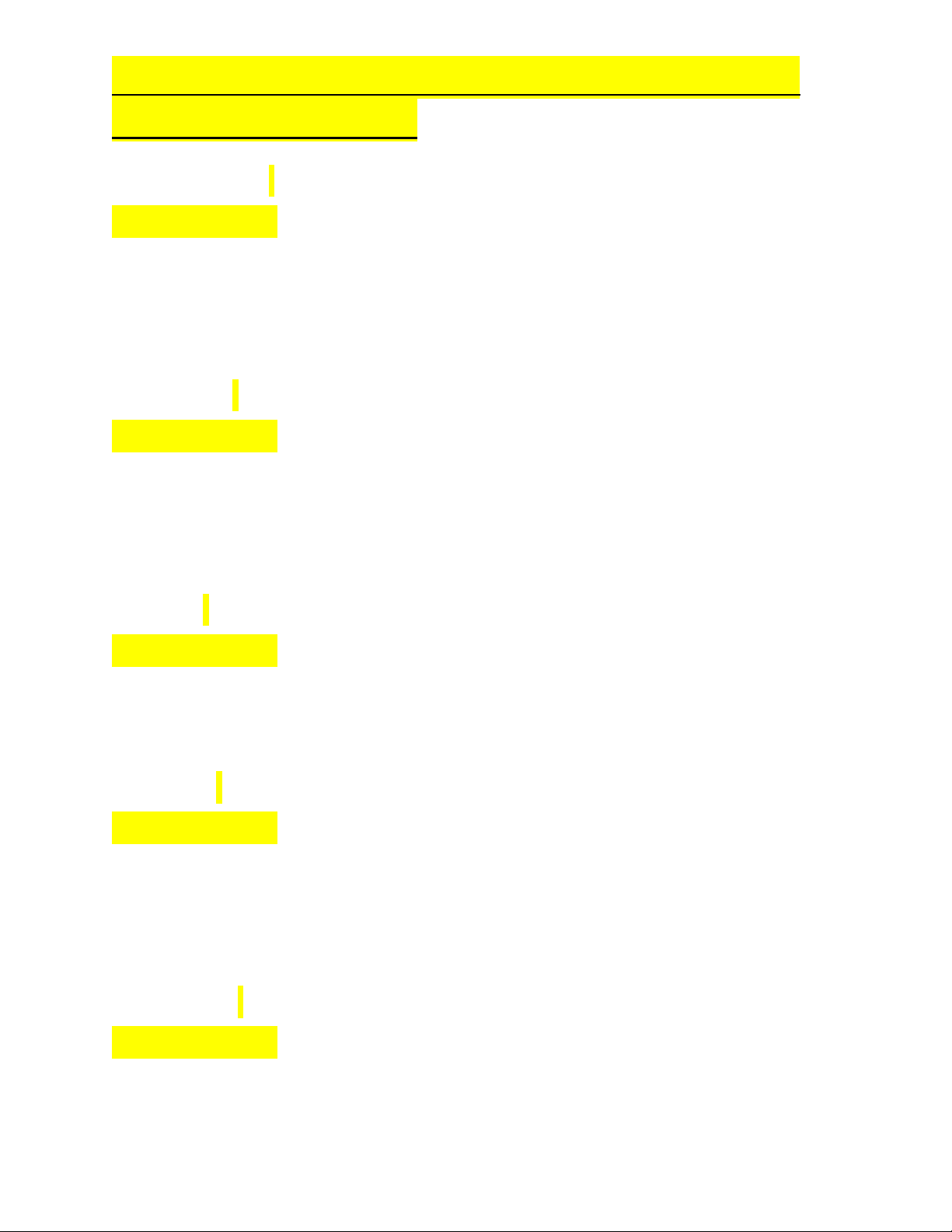
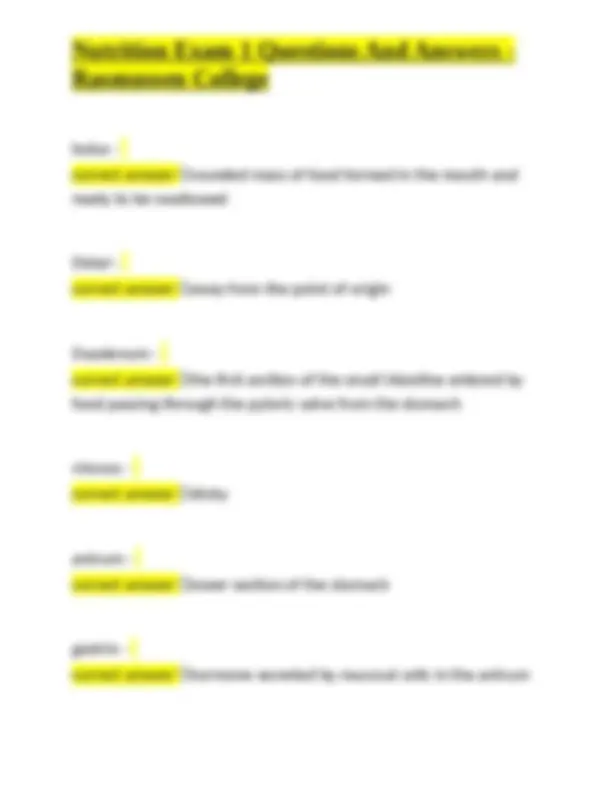
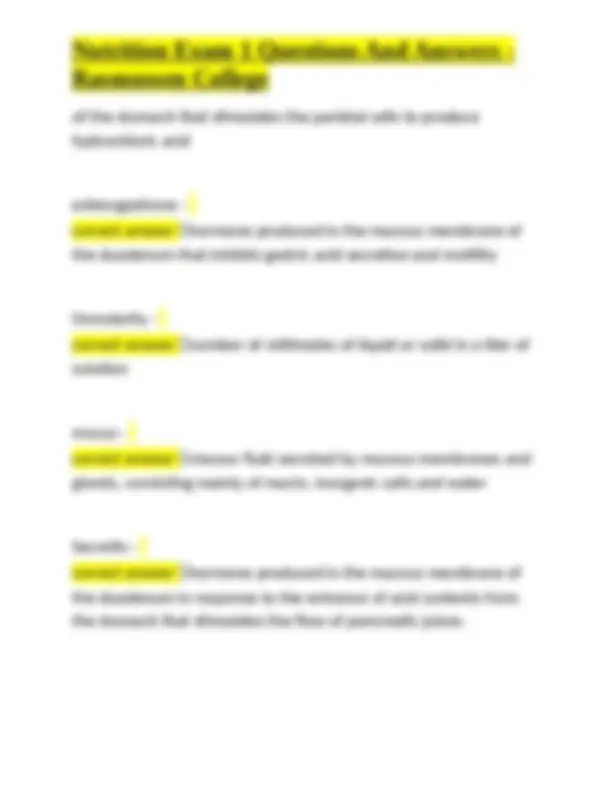
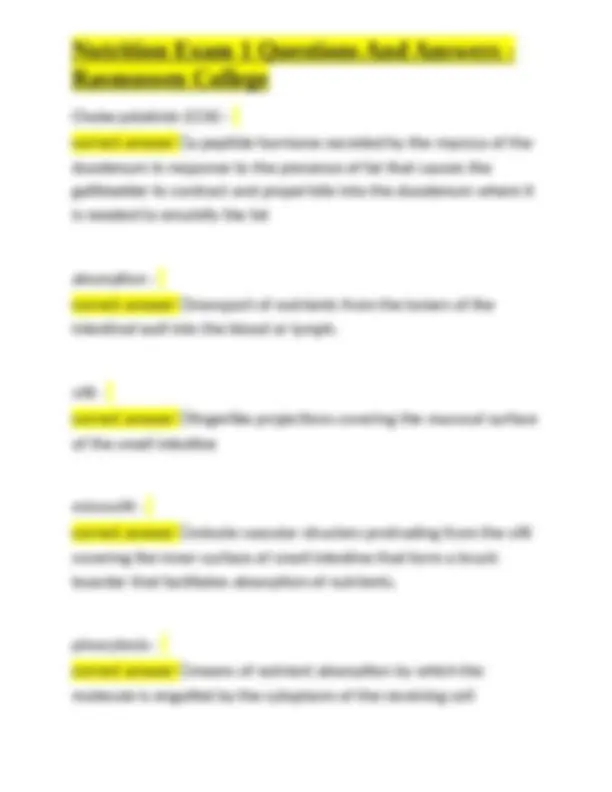
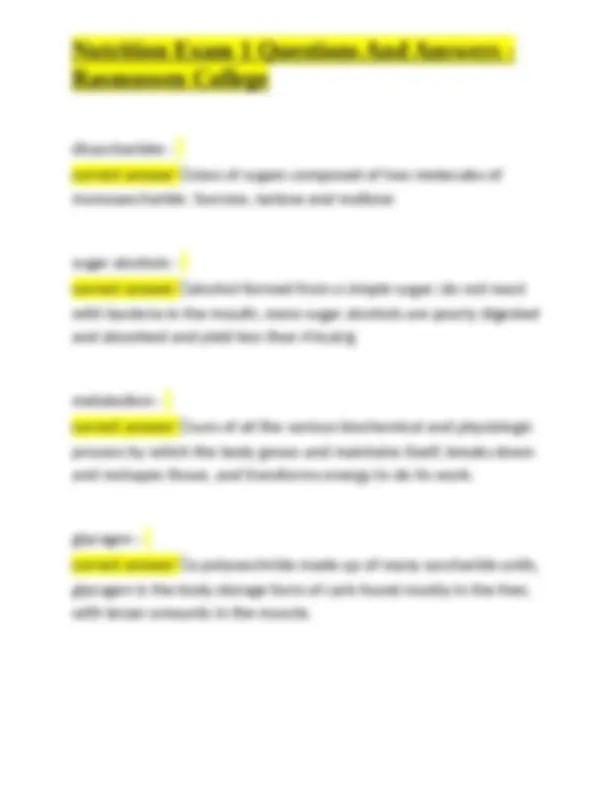
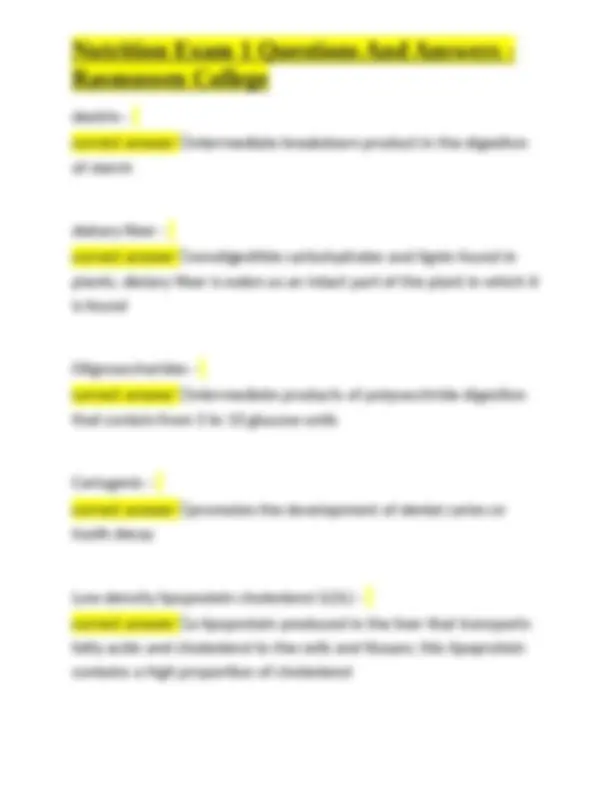

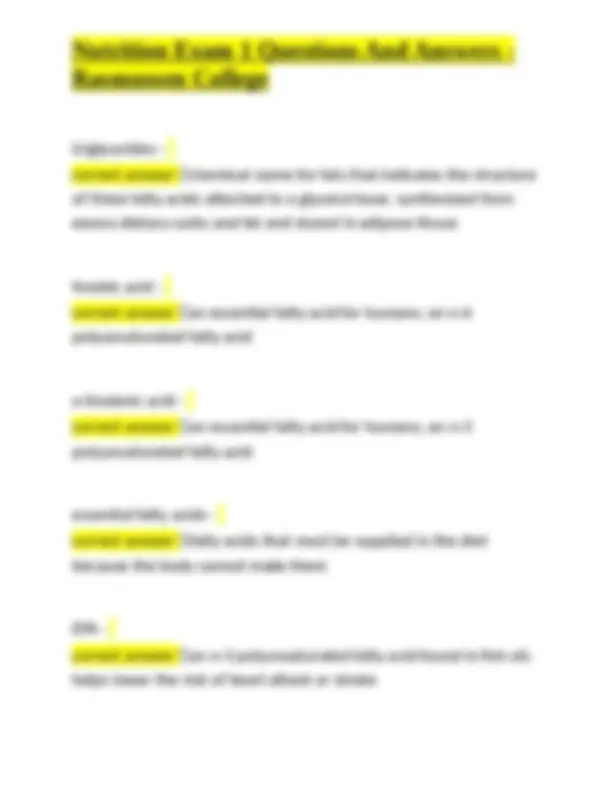
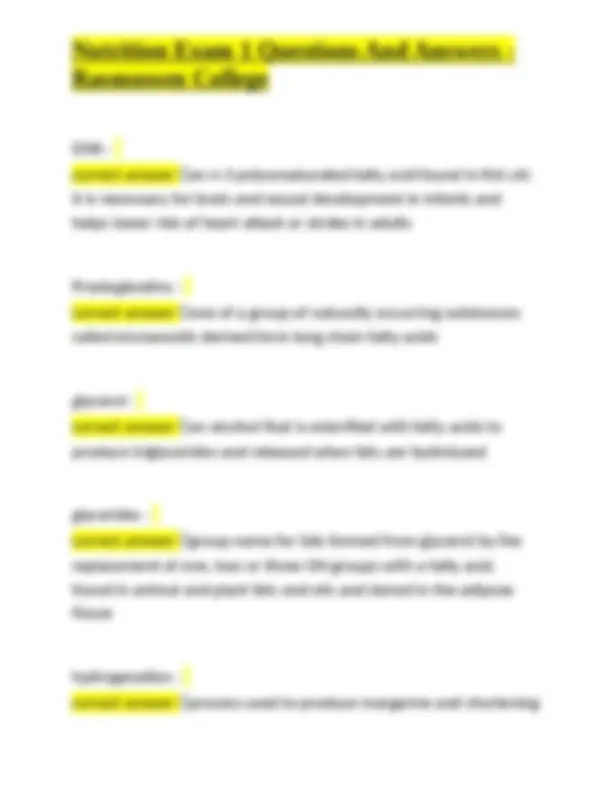
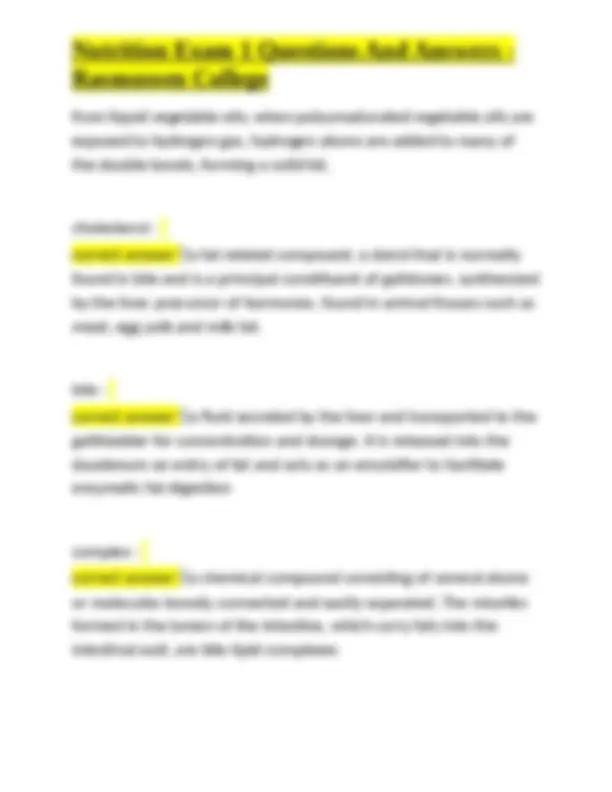
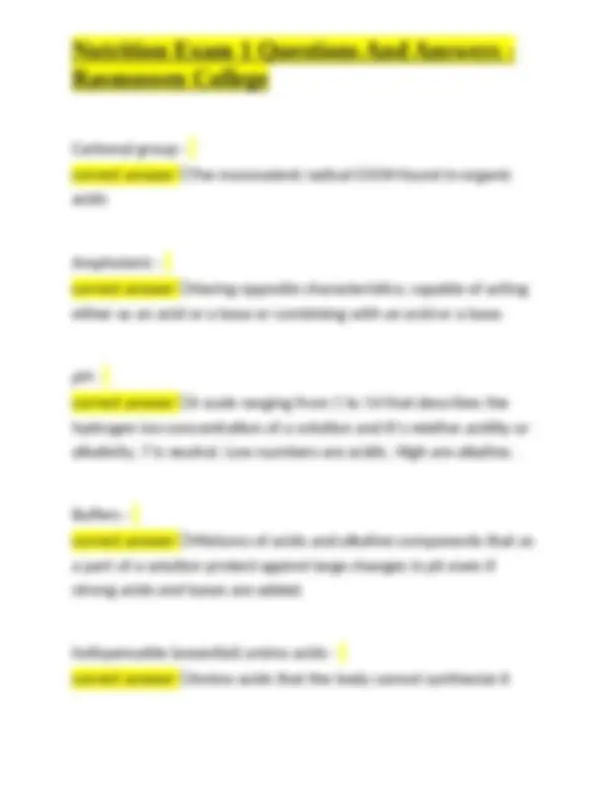
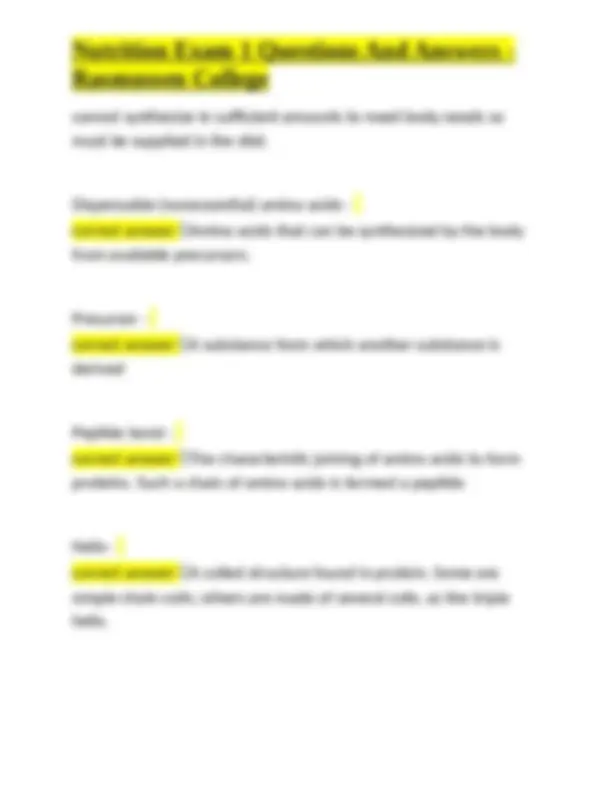
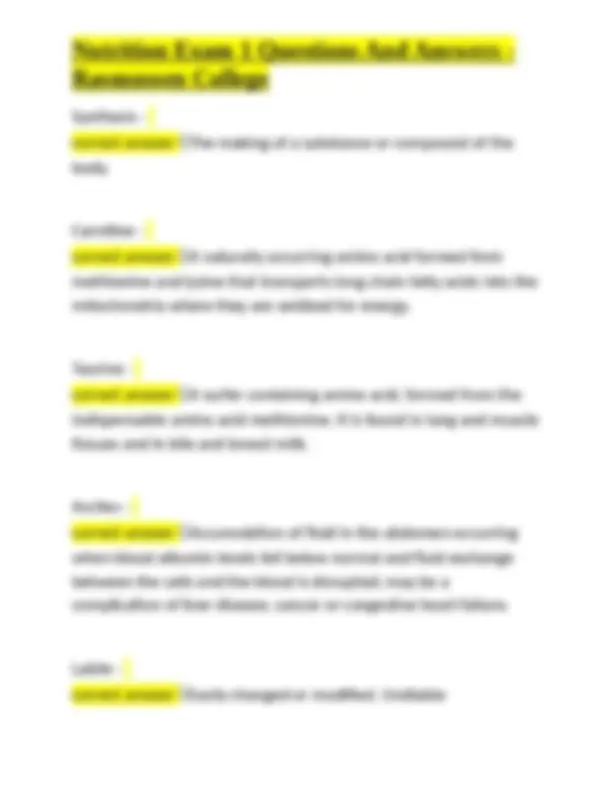
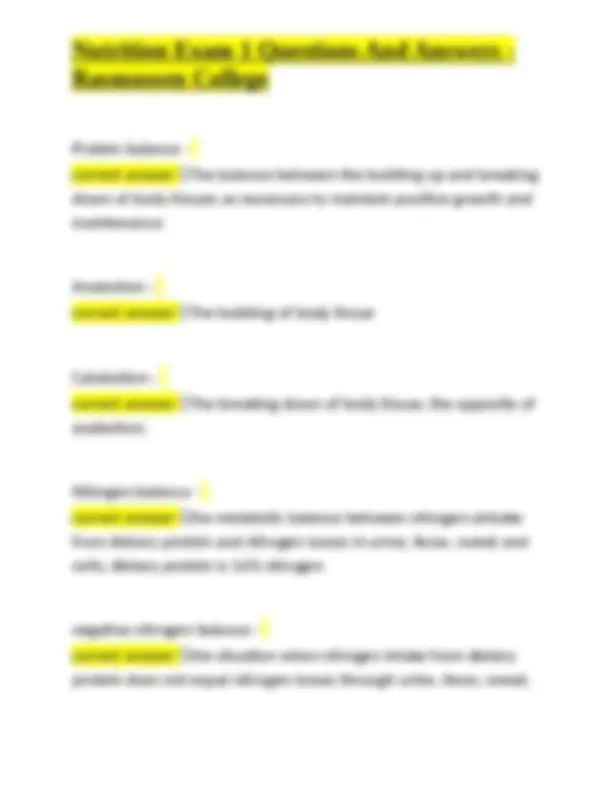
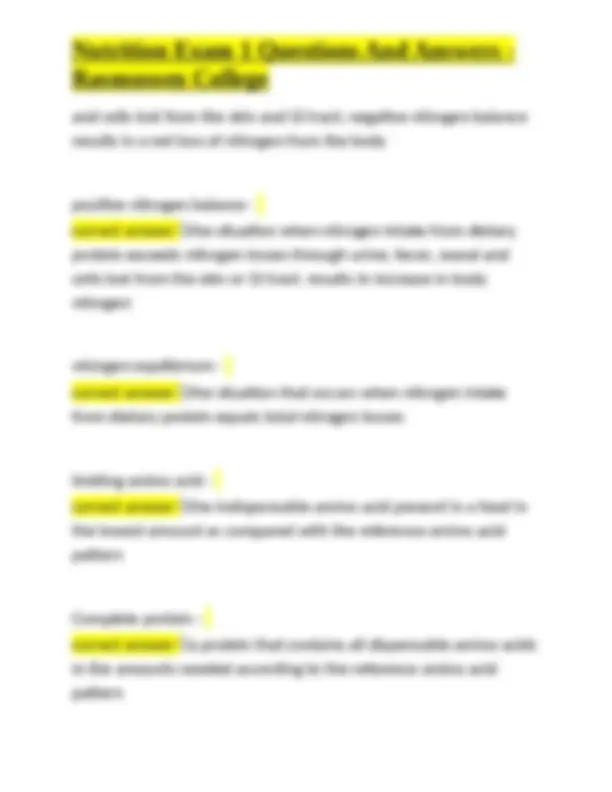
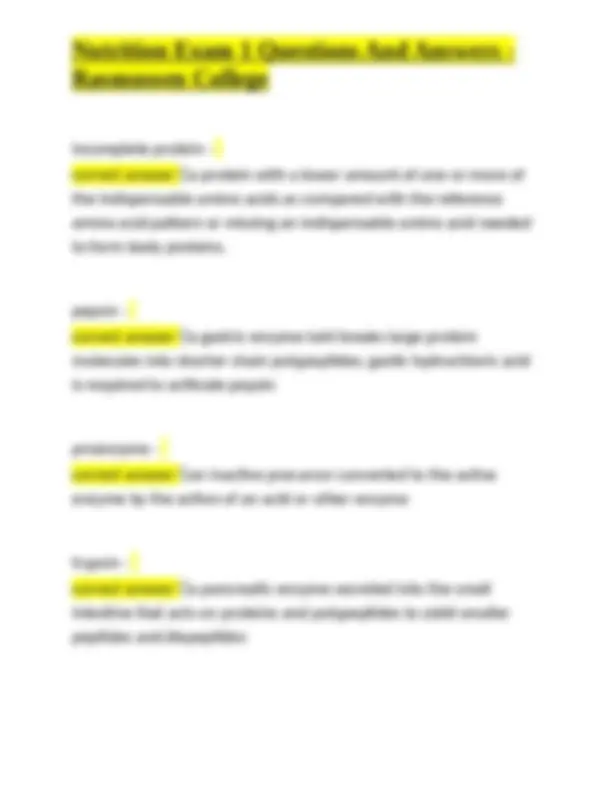
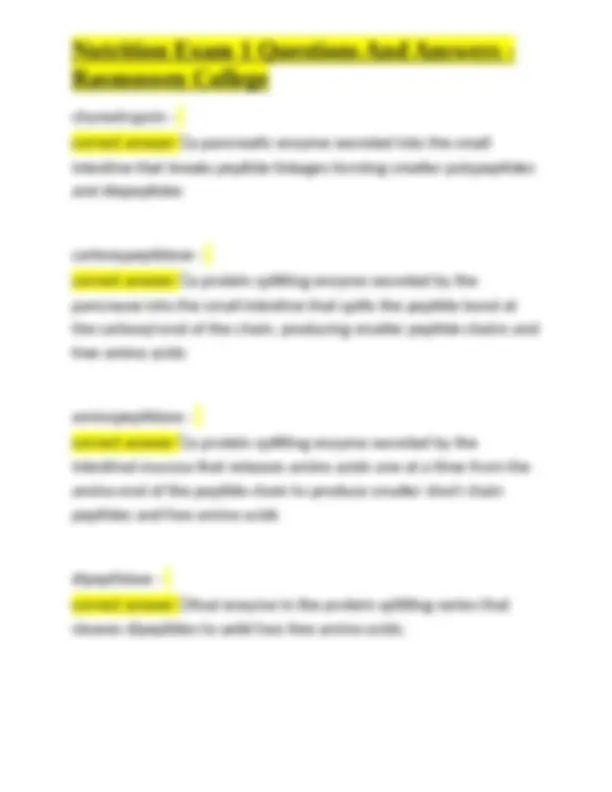


Study with the several resources on Docsity

Earn points by helping other students or get them with a premium plan


Prepare for your exams
Study with the several resources on Docsity

Earn points to download
Earn points by helping other students or get them with a premium plan
Community
Ask the community for help and clear up your study doubts
Discover the best universities in your country according to Docsity users
Free resources
Download our free guides on studying techniques, anxiety management strategies, and thesis advice from Docsity tutors
Nutrition Exam 1 Questions And Answers - Rasmussen College
Typology: Exams
1 / 24

This page cannot be seen from the preview
Don't miss anything!

















Homeostasis - correct answer ✅State of dynamic equilibrium within the body's internal environment; a balance is achieved through the operation of many interrelated physiologic mechanisms. Digestion - correct answer ✅The process of breaking down food to release its nutrients for absorption and transport to the cells for use in body functions Serosa - correct answer ✅Outer surface layer of the intestines interfacing with the blood vessels of the portal system that goes to the liver Mucosa - correct answer ✅The mucous membrane forming the inner surface of the GI tract with extensive nutrient absorption and transport functions. Peristalsis - correct answer ✅A wavelike progression of alternating contraction
and relaxation of the muscle fibers of the GI tract that keeps the food mass moving forward. Chyme - correct answer ✅Semifluid food mass resulting from gastric digestion Tonic - correct answer ✅ongoing low level muscle contraction and relaxation Intramural nerve plexus - correct answer ✅Network of nerves in the walls of the intestine that controls muscle action and secretions for digestion and absorption Gingivitis - correct answer ✅Red, swollen, bleeding gums, often caused by accumulation of bacterial plaque on the teeth. Pharynx - correct answer ✅throat
of the stomach that stimulates the parietal cells to produce hydrochloric acid enterogastrone - correct answer ✅hormone produced in the mucous membrane of the duodenum that inhibits gastric acid secretion and motility Osmolarity - correct answer ✅number of millimoles of liquid or solid in a liter of solution mucus - correct answer ✅viscous fluid secreted by mucous membranes and glands, consisting mainly of mucin, inorganic salts and water Secretin - correct answer ✅hormone produced in the mucous membrane of the duodenum in response to the entrance of acid contents from the stomach that stimulates the flow of pancreatic juices.
Cholecystokinin (CCK) - correct answer ✅a peptide hormone secreted by the mycosa of the duodenum in response to the presence of fat that causes the gallbladder to contract and propel bile into the duodenum where it is needed to emulsify the fat absorption - correct answer ✅transport of nutrients from the lumen of the intestinal wall into the blood or lymph. villi - correct answer ✅fingerlike projections covering the mucosal surface of the small intestine microvilli - correct answer ✅minute vascular structers protruding from the villi covering the inner surface of small intestine that form a brush boarder that facilitates absorption of nutrients. pinocytosis - correct answer ✅means of nutrient absorption by which the molecule is engulfed by the cytoplasm of the receiving cell
deamination - correct answer ✅removal of an amino group from an amino acid keto acid - correct answer ✅amino acid residue after deamination; the glycogenic keto acids can be converted to glucose. carbohydrate - correct answer ✅compound made up of carbon, hydrogen and oxygen. includes starches, sugars and dietary fiber photosynthesis - correct answer ✅process by by which plants containing chlorophyll are able to manufacture carbohydrate by combining co2 from the air and water from the soil with sunlift providing energy and chlorophyll as a catalyst monosacchraride - correct answer ✅simple sugar. carb containing a single saccharide. glucose, galactose and fructose.
disaccharides - correct answer ✅class of sugars composed of two molecules of monosaccharide. Sucrose, lactose and maltose sugar alcohols - correct answer ✅alcohol formed from a simple sugar; do not react with bacteria in the mouth; more sugar alcohols are poorly digested and absorbed and yield less than 4 kcal/g metabolism - correct answer ✅sum of all the various biochemical and physiologic process by which the body grows and maintains itself, breaks down and reshapes tissue, and transforms energy to do its work. glycogen - correct answer ✅a polysacchride made up of many saccharide units, glycogen is the body storage form of carb found mostly in the liver, with lesser amounts in the muscle.
High-density lipoprotein cholesterol (HDL) - correct answer ✅A lipoprotein produced in the liver that carries cholesterol from the tissues back to the liver for degradation and elimination Functional fiber - correct answer ✅nondigestible carbohydrates isolated from plant foods or synthesized and added to foods to increase their fiber content Total fiber - correct answer ✅dietary fiber plus functional fiber; the total amount of fiber in an individual's diet from all sources Energy density - correct answer ✅the relative number of kcalories per unit weight of food; foods high in fat and added sugar have high energy density; vegetables that contain large amounts of water and fiber have low energy density amylase - correct answer ✅a digestive enzyme that breaks down starch;
salivary amylase begins the digestion of starch in the mouth; pancreatic amylase enters the small intestine as part of the pancreatic secretions to continue starch breakdown in the duodenum sucrase - correct answer ✅enzyme that splits the disaccharide sucrose, releasing the monosaccharides glucose and fructose lactase - correct answer ✅enzyme that splits the disaccharide lactose, releasing the monosaccharides glucose and galactose maltase - correct answer ✅enzyme that splits the disaccharide maltose, releasing two units of the monosaccharide glucose portal - correct answer ✅an entryway, usually referring to the portal circulation of blood that delivers nutrients absorbed from the small intestine to the liver
triglycerides - correct answer ✅chemical name for fats that indicates the structure of three fatty acids attached to a glycerol base. synthesized from excess dietary carbs and fat and stored in adipose tissue linoleic acid - correct answer ✅an essential fatty acid for humans; an n- polyunsaturated fatty acid a-linolenic acid - correct answer ✅an essential fatty acid for humans; an n- polyunsaturated fatty acid essential fatty acids - correct answer ✅fatty acids that must be supplied in the diet because the body cannot make them EPA - correct answer ✅an n-3 polyunsaturated fatty acid found in fish oil; helps lower the risk of heart attack or stroke
correct answer ✅an n-3 polyunsaturated fatty acid found in fish oil; it is necessary for brain and neural development in infants and helps lower risk of heart attack or stroke in adults Prostaglandins - correct answer ✅one of a group of naturally occurring substances called eicosanoids derived form long chain fatty acids glycerol - correct answer ✅an alcohol that is esterified with fatty acids to produce triglycerides and released when fats are hydrolyzed glycerides - correct answer ✅group name for fats formed from glycerol by the replacement of one, two or three OH groups with a fatty acid. found in animal and plant fats and oils and stored in the adipose tissue hydrogenation - correct answer ✅process used to produce margarine and shortening
phospholipids - correct answer ✅a class of fat-related substances that contain a phophate group of fatty Chylomicrons - correct answer ✅Lipoproteins formed in the intestinal wall after a meal that carry food fats into the lymph and then the general circulation for transport to the liver Endogenous - correct answer ✅Originating from within the body. An example is endogenous cholesterol which is produced by cells in the liver Lipase - correct answer ✅Group of digestive enzymes that break down triglycerides to fatty acids and glycerol Emulsifier - correct answer ✅An agent that breaks down large fat globules to smaller, uniformly distributed particles increasing the surface area available to digestive enzymes and reducing the surface tension. This is the role of bike in the intestine
Micelles - correct answer ✅Complex of bile and fat that carries fat into the wall of the small intestine in preparation for the final stage of absorption into the lymph and general circulation Portal - correct answer ✅An entryway usually referring to the portal circulation of blood through the liver. Blood is brought into the liver via the portal vein and moves out via the hepatic vein. Enteric - correct answer ✅Relating to the intestine Amino acids - correct answer ✅Acids containing the essential element nitrogen within an amino group. Nh2. Amino acids are the structural units of protein. Amino group - correct answer ✅The monovalent radical nh2 an essential component of all amino acids
cannot synthesize in sufficient amounts to meet body needs so must be supplied in the diet. Dispensable (nonessential) amino acids - correct answer ✅Amino acids that can be synthesized by the body from available precursors. Precursor - correct answer ✅A substance from which another substance is derived Peptide bond - correct answer ✅The characteristic joining of amino acids to form proteins. Such a chain of amino acids is termed a peptide Helix - correct answer ✅A coiled structure found in protein. Some are simple chain coils; others are made of several coils, as the triple helix.
Synthesis - correct answer ✅The making of a substance or compound of the body. Carnitine - correct answer ✅A naturally occurring amino acid formed from methionine and lysine that transports long chain fatty acids into the mitochondria where they are oxidized for energy. Taurine - correct answer ✅A surfer containing amino acid, formed from the indispensable amino acid methionine. It is found in lung and muscle tissues and in bile and breast milk. Ascites - correct answer ✅Accumulation of fluid in the abdomen occurring when blood albumin levels fall below normal and fluid exchange between the cells and the blood is disrupted; may be a complication of liver disease, cancer or congestive heart failure. Labile - correct answer ✅Easily changed or modified. Undtable